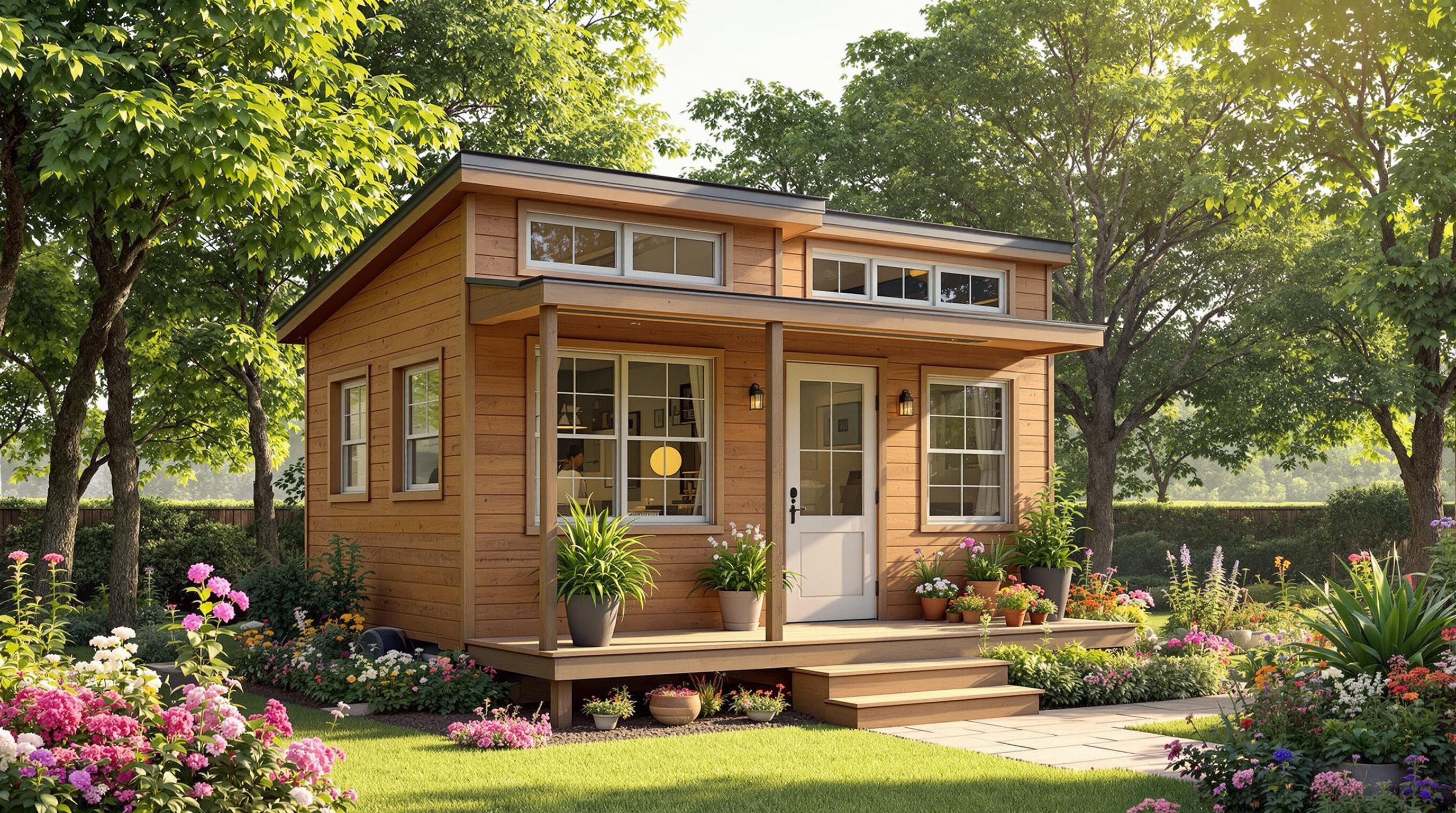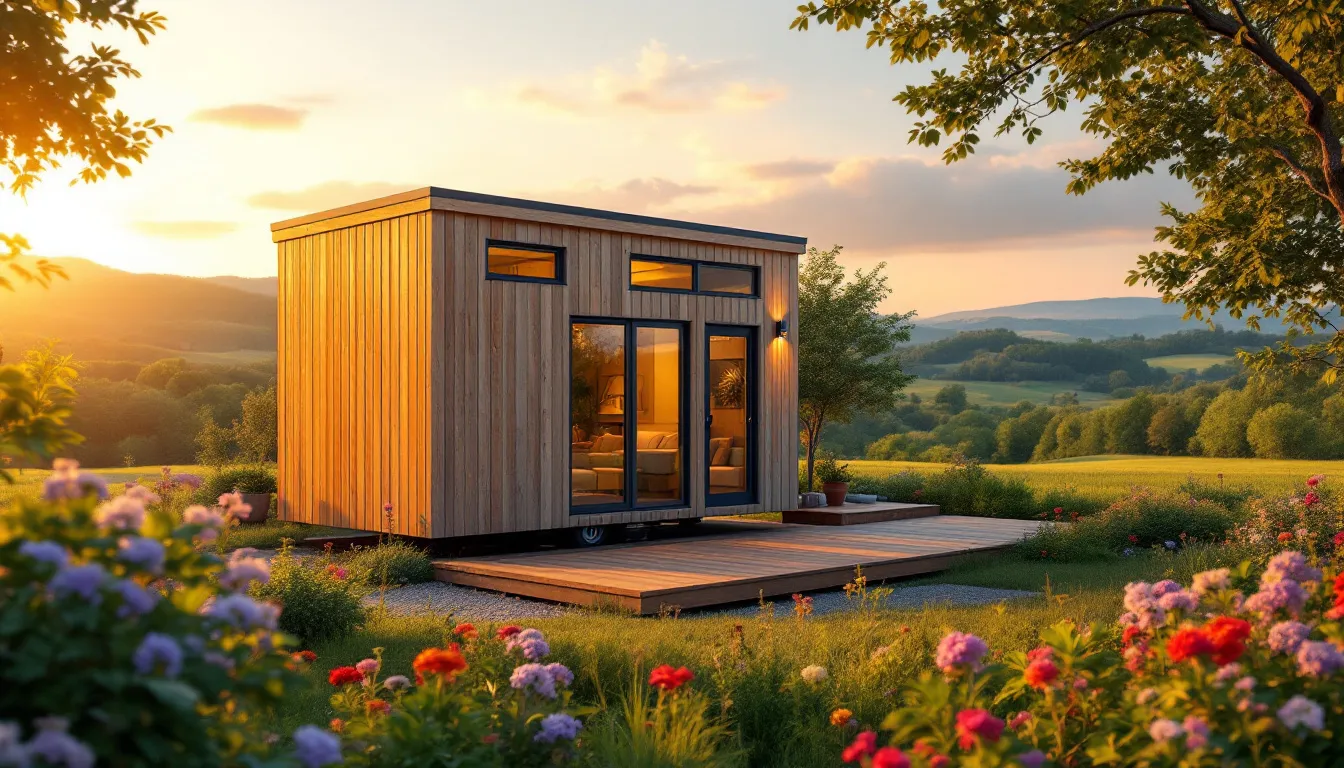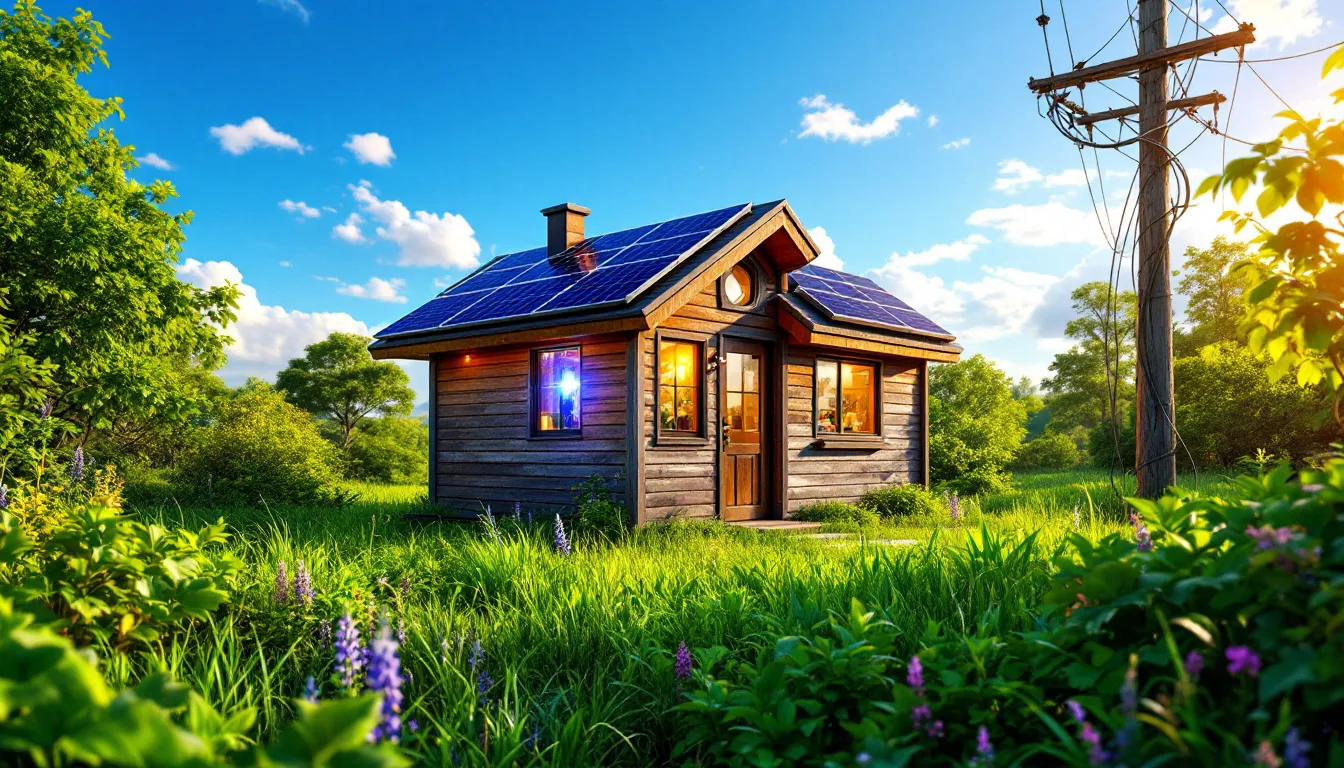Living in a tiny house offers financial savings, a simpler lifestyle, and reduced environmental impact. These compact homes, typically 100-400 square feet, are cheaper to build or buy, cost less to maintain, and consume fewer resources. Whether you're building or purchasing, here’s what you need to know:
- Planning: Research local zoning laws, set a realistic budget, and design a layout that fits your needs.
- Building: Use durable materials, focus on smart storage, and choose energy-efficient systems.
- Buying: Look for certified builders, explore financing options like RV loans, and inspect thoroughly.
- Living: Optimize space with multi-functional furniture, vertical storage, and light colors to create an open feel.
Tiny homes prioritize affordability, functionality, and sustainability. This guide covers everything from regulations and construction to daily living tips to help you get started.
Tiny House Reality Check! Watch This Before Building or Buying One
Getting Started with Tiny Houses
Proper preparation is key to starting your tiny house journey. Let’s break down the main steps to help you get started on the right foot.
Understanding Local Rules and Laws
Before anything else, check with your city or county planning department to understand the rules that apply in your area. Pay attention to:
- Zoning and size restrictions: These dictate where you can place your tiny house and how big it can be.
- Building codes and safety standards: Ensure your tiny house meets structural and safety requirements.
- Legal classification: Some states classify tiny houses on wheels as RVs, which can affect where you can park, as well as insurance and financing options [3].
Once you’ve got a clear understanding of the legal landscape, you can move on to creating a realistic budget.
Planning Your Budget
Tiny homes are generally less expensive than traditional houses, but careful budgeting is still critical. Here's a breakdown of common costs:
| Expense Category | Cost Range | Notes |
|---|---|---|
| Land/Lot | $5,000 - $50,000 | Depends on location |
| Building Materials | $15,000 - $40,000 | Includes finishes |
| Labor (if hired) | $10,000 - $30,000 | Builder fees |
| Utilities Setup | $5,000 - $15,000 | Covers utility connections |
| Permits/Legal | $1,000 - $5,000 | Varies by jurisdiction |
It’s smart to set aside an extra 15-20% as a contingency fund. Also, decide early on if you’ll connect to the grid or go off-grid, as this choice will influence your overall expenses [2][4].
With your budget in place, you’re ready to think about the size and layout of your tiny home.
Picking the Right Size and Layout
When designing your tiny house, focus on how the space will work for your lifestyle. Consider:
- Daily activities and the needs of everyone living there.
- Storage requirements, including long-term and daily-use items.
- Flexibility for future changes in your lifestyle.
A helpful tip is to use painter’s tape to outline your floor plan on the ground. This gives you a real sense of the space before committing to a design [4]. Most tiny homes fall between 200-400 square feet, offering a balance of comfort and efficiency.
To make the most of your space, think about:
- Multi-functional areas
- Vertical storage options
- Hidden storage, like under-floor compartments
- Furniture that can fold or collapse when not in use
These considerations will help you create a tiny home that’s both functional and comfortable.
How to Build a Tiny House
Building a tiny house takes careful planning and precision. Here's a breakdown of the key steps and decisions involved in creating your compact living space.
Preparing the Base
The base of your tiny house is critical for long-term stability and safety, whether you're going for a mobile or stationary setup. If you're building a mobile tiny home, choose a trailer specifically designed for this purpose. These trailers typically cost between $3,500 and $5,500.
| Feature | Specification | Why It Matters |
|---|---|---|
| Weight Capacity | 10,000-14,000 lbs | Supports the entire weight of the house |
| Frame Material | Galvanized Steel | Resists rust and adds durability |
| Size Options | 20-28 feet | Common lengths for tiny homes |
| Certification | Certified for road travel | Ensures compliance with RVIA/DOT rules |
For a fixed foundation, you'll need to hire a local contractor to install a concrete slab or pier foundation that meets building codes in your area. Before starting, make sure the ground is level and has proper drainage.
Building and Choosing Materials
The materials you use will determine both the strength and weight of your tiny house. Standard options include 2x4 lumber for walls, 2x6 for floor joists, or steel framing for a lighter yet sturdy alternative. For insulation, consider spray foam for better energy efficiency (around $2 per square foot) or fiberglass batts for a more affordable option (about $0.50-$1 per square foot).
Exterior Materials:
- Siding: Durable choices like fiber cement or metal will cost $1,000-$2,500.
- Roofing: Metal or architectural shingles range from $500-$2,000.
- Windows: Basic vinyl windows are $200-$300 each, while energy-efficient models can go up to $1,000.
Adding Utilities
Electrical System: Set up a 100-amp panel or install solar panels with battery storage, and carefully plan where outlets will go for maximum convenience.
Plumbing:
- Use PEX piping for its flexibility and resistance to freezing.
- Install a tankless water heater to save space.
- Composting toilets are a great option for reducing water usage.
HVAC:
- Mini-split systems are compact and handle both heating and cooling.
- Proper ventilation is crucial; make sure to include effective systems.
- Don't forget carbon monoxide and smoke detectors for safety.
Once your tiny house is complete, you can start looking into purchasing or financing options for a finished home.
How to Buy a Tiny House
If building a tiny house doesn’t feel like the right fit, purchasing one from a reliable builder can be a great option.
Finding Reliable Builders
Choosing the right builder is key to making sure your tiny house is safe and worth the investment. Start by researching builders through trusted directories like Tiny Houses For Sale, Rent, and More (tinyhousesearch.com), which provides a curated list of manufacturers and their credentials.
When assessing builders, focus on these areas:
| Verification Point | What to Check | Why It Matters |
|---|---|---|
| Certifications | RVIA/NOAH certification | Ensures the home meets safety standards |
| Build Quality | Material quality, warranties | Affects durability and resale value |
| Track Record | Years of experience, completed projects | Reflects expertise and reliability |
| Customer Reviews | Testimonials and photos | Offers insight into the builder’s work |
Ask to visit the workshop to see how the houses are built. Pay close attention to the materials, structural soundness, and adherence to safety protocols. Trustworthy builders often provide warranties for major systems and components, typically lasting at least one year.
Financing Your Tiny House
Financing a tiny house is different from funding a traditional home. Since standard mortgages usually don’t apply, you’ll need to explore other options.
Personal Loans: These unsecured loans come with interest rates ranging from 6% to 36%, depending on your credit score. Many online lenders offer loans specifically for tiny homes, with terms between 3 and 7 years.
RV Loans: If your tiny house has RVIA certification, you may qualify for an RV loan. These loans often feature lower interest rates, longer repayment periods (up to 15 years), and smaller down payments (10-20%).
Other Financing Options:
- Manufacturer financing programs
- Home equity loans (if you own land)
- Construction loans for DIY projects
- Local credit unions offering tiny home loans
Things to Keep in Mind:
- Factor in costs like site preparation, lot rental fees, utilities, and ongoing maintenance.
- Think about resale value and market trends in your area.
Before committing to a purchase, hire an independent inspector to examine the house. They can confirm it meets local building codes and flag any issues that might complicate financing or insurance.
Once your tiny house is ready, the next step is making it a cozy and functional space to call home.
sbb-itb-2ef3f3a
Living in a Tiny House: Tips for Comfort and Functionality
Once your tiny house is ready, the next challenge is turning it into a comfortable and practical living space.
Smart Storage Ideas
In a tiny house, every inch counts. Use vertical spaces like wall-mounted shelves, pegboards, or magnetic strips to keep items within reach without cluttering the floor. Hidden spaces, such as under-floor compartments or stair storage, are perfect for stashing less-used items. Multi-functional furniture, like storage ottomans or benches with built-in drawers, combines utility with clever design.
| Storage Zone | Solutions | Why It Works |
|---|---|---|
| Vertical Space | Wall shelves, pegboards, magnetic strips | Keeps items off the floor and easy to grab |
| Hidden Areas | Under-floor storage, stair compartments, ceiling racks | Makes use of areas often overlooked |
| Multi-purpose Furniture | Storage ottomans, benches with drawers | Doubles as seating and storage |
Space-Saving Furniture
Furniture that serves multiple purposes is key. Think Murphy beds, expandable tables, and modular sofas with hidden storage. These pieces keep your home flexible and clutter-free. Here are some ideas:
- Expandable tables: Shift from coffee table to dining table in seconds.
- Modular sofas: Built-in storage compartments for blankets, books, or anything else.
- Nesting furniture: Stack or tuck away when not in use to save space.
Planning a Functional Layout
A well-thought-out layout can make even the smallest home feel comfortable. Focus on clear walkways, accessible storage, and designated areas for different activities. Placing the kitchen near the entrance can add convenience, while light colors and mirrors create the illusion of more space.
"Under-floor storage is an excellent way to keep your home uncluttered while maximizing usable space", says Ric Butler, Vice President of the Australian Tiny House Association.
For a more functional setup:
- Dedicate a workspace if you work from home.
- Install proper lighting to brighten and open up the space.
- Use mirrors and light colors to make rooms feel larger.
With these tips, your tiny house can be both practical and inviting, tailored to your needs and style.
Helpful Resources for Tiny House Owners
Whether you're building, buying, or transitioning to life in a tiny house, these tools and communities can make the process smoother and help tackle common challenges.
Directories and Communities
If you're searching for builders, communities, or properties, Tiny Houses For Sale, Rent, and More (tinyhousesearch.com) is a great place to start. It offers a wide-ranging directory to help you find what you need.
| Platform | Key Features | Ideal For |
|---|---|---|
| Tiny House Swoon | Photo galleries, build stories, design ideas | Inspiration and planning |
| Tiny House Listings | Marketplace, builder reviews, forums | Buying or selling tiny homes |
| The Tiny Life | Educational content, community discussions | Learning and connecting |
Once you've found a community or builder that fits your needs, you can dive into resources for DIY building projects.
DIY Kits and Plans
Planning to build your own tiny house? Platforms like The Tiny Life provide step-by-step guides, including detailed checklists to help you stay organized. These checklists cover everything from materials to construction phases. They also suggest using materials like spray insulation, which improves energy efficiency while adding structural support [1].
Even with solid plans, you might still face questions about legal requirements, off-grid setups, or financing.
Answers to Common Questions
House Beautiful is an excellent resource for tackling major concerns, including:
- Zoning laws and legal requirements
- Solutions for off-grid living
- Building code compliance
- Securing local authority approvals [3]
For zoning specifics, consult House Beautiful or reach out to your local planning department. If you're navigating financing, tools like Quicken Loans offer advice tailored to tiny house buyers [5].
These resources - whether from local authorities, The Tiny Life, or Quicken Loans - can provide clarity on zoning laws, construction tips, and financial planning.
Conclusion: Start Your Tiny House Journey
Living in a tiny house offers a chance to simplify life while saving money and reducing your impact on the planet. To make this work, careful planning is key - especially when it comes to budgeting, design, and utilities. Having a realistic budget is essential to avoid surprises. Make sure to focus on the basics like the foundation, materials, and utilities, and keep an emergency fund for unexpected costs.
Important considerations like local zoning regulations, design decisions, utility setups, and material quality will play a big role in your experience. Take the time to research these areas thoroughly to ensure your tiny home is practical, functional, and meets legal requirements.
If you're ready to dive in, here’s how to get started:
- Research and Planning: Explore tiny house communities and resources like Tiny House Swoon or The Tiny Life to gather ideas and advice.
- Budgeting: Calculate all costs, including materials, labor, and a buffer for unexpected expenses.
- Design Choices: Decide if you’ll tackle a DIY build, use pre-made plans, or hire a professional builder - this depends on your skills and available resources.
Tiny house living requires flexibility and smart thinking. Focus on designing a space that fits your lifestyle while keeping it practical. Using eco-friendly materials, efficient layouts, and clever storage solutions can help you create a home that’s both cozy and mindful of the environment.
Start your journey by reaching out to builders, joining tiny house communities, or attending workshops. Whether you plan to build or buy, the tips in this guide can help you move forward with confidence.
FAQs
How to maximize storage in a tiny home?
In addition to the basics mentioned earlier, here are some clever ideas from seasoned tiny house owners:
| Storage Area | Solutions | Benefits |
|---|---|---|
| Kitchen | Retractable countertops, magnetic strips, pull-out pantries | Adds workspace and keeps things organized |
| Hidden Areas | Custom under-stair drawers, ceiling storage | Makes use of overlooked spaces |
| Multi-Purpose | Murphy beds, fold-down desks | Adjusts easily for different activities |
What's the best way to ensure structural integrity?
Collaborate with certified experts familiar with tiny house construction. Key steps include:
- Using a trailer rated for at least 4 tonnes to handle the home's weight.
- Installing proper anchoring and foundation systems.
- Adhering to local building codes.
- Adding spray insulation for better energy efficiency and stability. [2][4]
How do I navigate zoning laws and insurance?
Reach out to your local planning office to understand zoning regulations specific to your area. For insurance, look for companies that specialize in tiny or mobile homes. Make sure to get a clear explanation of coverage details and any limitations. [3][5]
What are common mistakes to avoid?
"The key to living in a tiny house is not just about downsizing, but about maximizing the space you have." - Alexis Stephens, Tiny House Swoon
Here are some frequent missteps and how to avoid them:
- Poor planning for electrical and plumbing setups.
- Starting construction without researching zoning laws.
- Ignoring weight distribution, which is crucial for safe towing.
- Failing to design storage solutions during the initial planning phase. [2][5]
Being aware of these challenges upfront can help you work with the right professionals to bring your tiny house dream to life.
How can I find reliable builders?
Look for builders with RVIA or NOAH certifications and request the following:
- Detailed contracts that specify materials and timelines.
- Warranty information in writing.
- Opportunities to visit workshops and see construction methods firsthand.
- References from recent clients. [4][5]
If you're going the DIY route, start with professional building plans or connect with experienced tiny house communities for advice and support.



